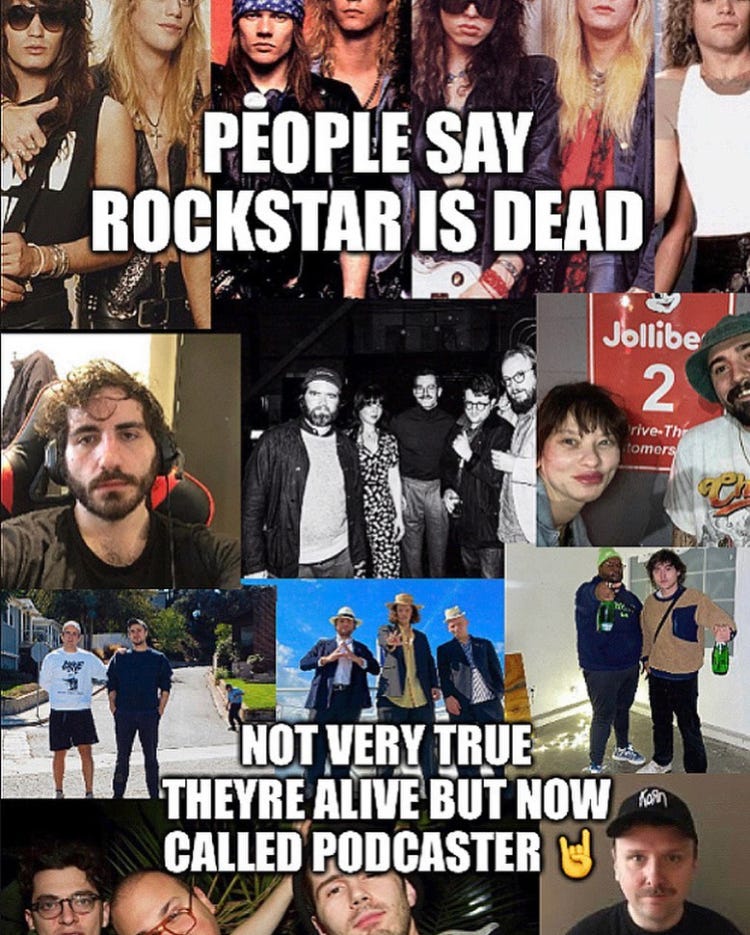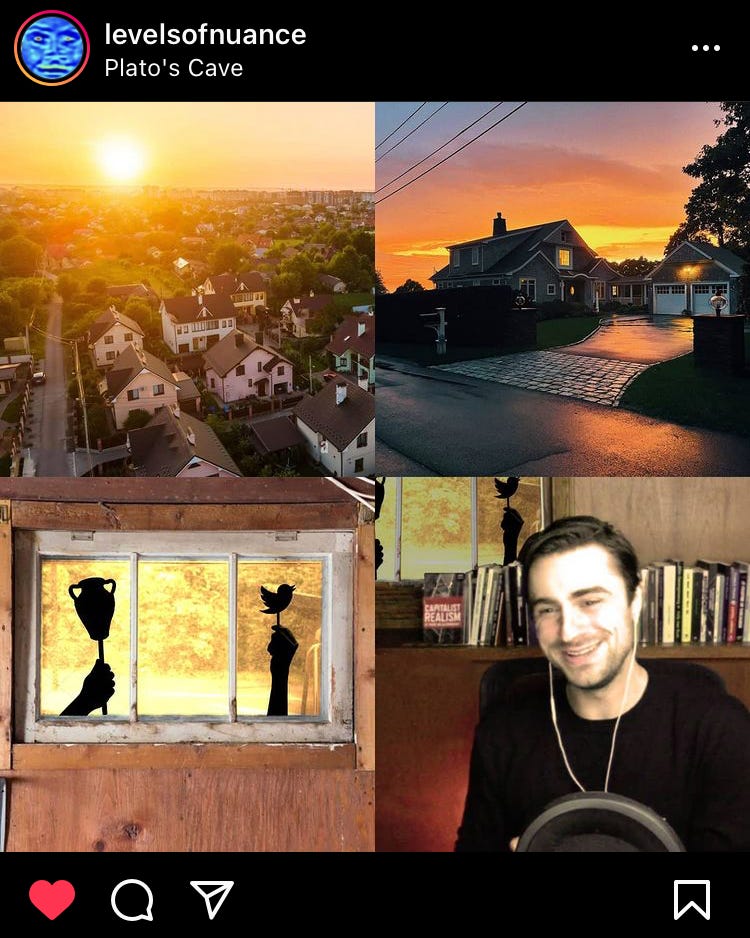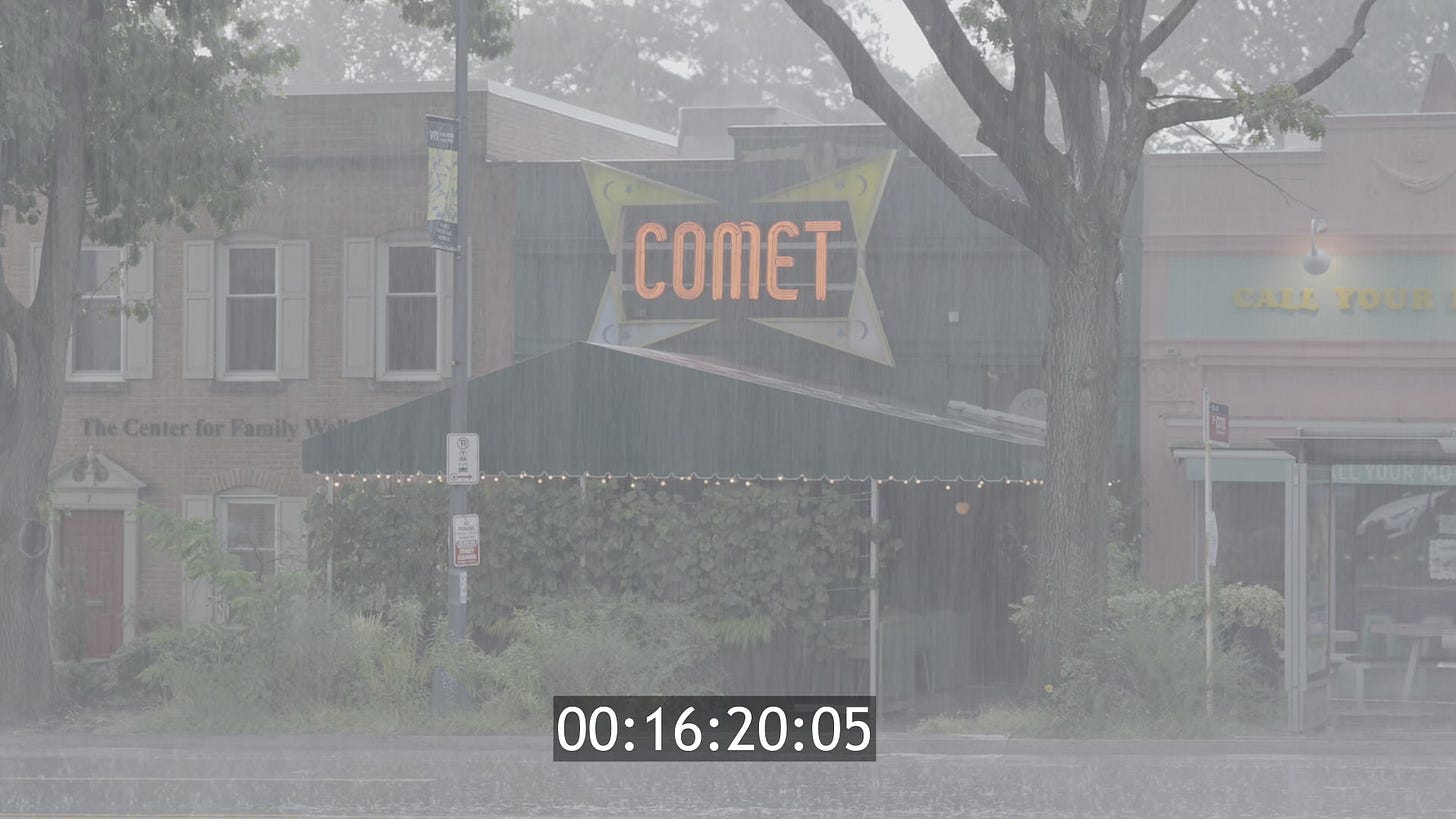If you’re around NYC next week, join me on Thursday, Sept 4th, at 5:30pm at Gagosian gallery (821 Park Ave), for the opening of “Peace Core”, an exhibition by Christopher Kulendran Thomas. CKT and I will host a conversation, followed by an opening reception from 6 to 8pm. Event is free. RSVP here.
▶️ Find Doomscroll audio episodes on Apple, Spotify and all other podcast apps.
This week, I’m writing from Washington DC as I shoot some very special new episodes for the show. It’s crazy to say this—but we’re coming up on the first year of Doomscroll. I’m blown away by the success of this project and I’m grateful for your support. As we approach the one year mark, I thought I would take this time to reflect on the project thus far.
Doomscroll began as a 12 episode mini-series. Back in February of 2023, I started a conversation with friends and producers, Riel Roch-Decter and Clark Filio, that would continue for the next 18 months. Together, we envisioned a deep exploration into online culture and radical politics. This series would take the topics of my earlier writing and research into an artful video format. After more than a decade of showing art in galleries and museums, Doomscroll has been an unexpected yet oddly fitting evolution of my work and creative practice.
What We Did Right
In the past year, I’ve heard a few people half-jokingly call Doomscroll a “prestige podcast”. Before the “golden era of TV” in the early 2000s, producers saw ambitious shows as a waste of time and money. Episodic television was considered a low budget format in which to sell advertising. After a few groundbreaking “prestige television” series, the industry realized that, in fact, there had always been a demand for better quality programming but no one had yet bothered to try it. Soon after, the medium was seen in a new light and rightfully understood as its own unique art form.
I think we cracked something similar for online content. We successfully elevated a format that most people had written off as kitsch. For the past decade, podcasts have been incredibly relevant but generally approached as low quality programming. Post-2024 election, the medium was suddenly recognized as the most influential cultural form of the era. Already, there are several major podcasts that have begun to emulate our signature look and style. None of them are quite as good :P
The cinematic quality of the show also allows us to explore silly or “extremely-online” topics that can sometimes be difficult to take seriously. Like many things on the internet, these subjects are hastily dismissed by the mainstream but have become increasing influential in the real world. Addressing these topics has opened up many long overdue conversations about the political impact of online culture.
In style and in substance, I’m proud of the work we have done over the past year. We’ve got some amazing episodes in production with an unbelievable line up of guests. You can help this project continue and get access to an additional 17 bonus episodes by becoming a paid subscriber:
What We Did Wrong
In May of this year, I wrote about the guiding philosophy and media strategy of this program:
By intentionally broadening the scope of our guest list, I am purposefully seeking to bring in audiences that do not align with my own views and in some cases may be actively hostile to other ideas that are presented on the show. Eventually, I plan to expand this scope more widely.
Some of my early attempts to fulfill this strategy have performed poorly. And while clicks aren’t everything—they’re not nothing. To build a new pipeline, we need ‘outside-of-niche’ episodes to serve as a real method of discovery and to broaden the ideological scope of the audience. Unless we achieve certain levels of engagement, we cannot truly say that we are building an effective politicization funnel.
On the RSS feed and behind the paywall, our core audience appreciates these ‘outside-of-niche’ videos at a consistent level. I also feel confident that the quality of these episodes has remained the same. But the particularity of the YouTube algorithm presents a significant challenge. Right now, there are overwhelming incentives for creators to produce nearly identical content at regular intervals. For-You-Pagification makes it especially difficult for channels to build diverse audiences. For the New Pipeline strategy to work, we need to align this abstract theory with the algorithmic tools that exist in the real world. Anything else will fail to make a real impact. To accomplish this, I’m going to attempt a few things:
For episodes with ‘outside-of-niche’ guests, you’re going to hear more editorial feedback from me, especially in the first few minutes of the video. This will help to increase watch-times with our existing base audience. Curiously, unless we get some degree of early engagement from regular viewers, the YouTube algorithm will not assemble a dataset to serve this content to anyone outside of our isolated group.
I’m going to space out these ‘outside-of-niche’ episodes a bit further. In some cases, video views can unpredictably drop off. Creators call this “algorithmic jail”. Algorithms are a black box and its hard to predict how they will react. Adding more time between these episodes will help to hedge this ever-present risk.
As we ramp up production later this year, and increase the frequency of our videos, these “pipeline” episodes will also become less risky. For example, at a pace of 3 public episodes per month, we can more easily upload and sustain successful views on 1 ‘outside-of-niche’ video book-ended between 2 episodes that reliably appeal to our regular viewers.
Furthermore, the politically diverse guests that we bring on need to have some level of public visibility that will drive external traffic. As the show gets bigger, this will become less essential. But right now, there is a high risk of algo-jail for newer channels that attempt to break out of their echo chamber.
Having spoken with some very large creators in this space, I’ve charted an interesting path for the next season. I’m optimistic about what we can achieve. The purpose of this newsletter is to try and solve our current alt-media puzzle. I’ll continue to write and provide updates as we make progress towards this goal.
On a more speculative note, platforms as a whole are incrementally shifting into a hybrid economic model. The filter bubbles of the past decade are primarily a downstream effect of ad-driven design. As platforms introduce new methods of monetization, and AI slop floods ad-driven platforms, new space will open up for more durable forms of programming. When it does, Doomscroll will be well positioned with a back catalog of high quality content.
Lastly, I want to say that some of the missteps of the past year have been on me. In the five years that I’ve been making podcasts, I’ve learned to speak clearly to an audience of 10k dedicated listeners. In the past, my audience would generally have some knowledge or familiarity with a core set of books and references. But the scale increase of Doomscroll has been a real challenge. Over the past year, we’ve reached an average weekly audience of ~125k viewers. On more than a few occasions, I have failed to contextualize why certain topics are important. For example, when Yancey Strickler and I discuss our shared observations about the rise of “private states”, some of our new viewers do not yet understand that we consider this to be a bad thing lol. There has been a big learning curve over the past year.
From the familiar scale of a 10 person graduate seminar, to my previous 10k audience of podcast listeners, to our current 100k viewers on a YouTube video, it becomes increasing difficult to assume that audiences have any shared or prerequisite knowledge for the topics being discussed. (Particularly in the case of esoteric or niche political theories.) In hindsight, this sounds obvious but its been a painful and often embarrassing learning experience.
Over the next year, I’m going to do my best to frame certain subjects in the proper light and to make them accessible to a wider audience. We’re only at the beginning of this project and there is a long way to go. Sometimes, I really fuck up and we have to cut out the whole segment. On some of our forthcoming episodes, you will see me trying out a few new approaches.
Editorial Freedom
It’s almost one year into the show and we’ve published 46 videos; 29 on the public feed and 17 private episodes. In that time, the channel has accumulated over 5.5 million views and is about to pass its first 100,000 followers. On the weeks we don’t upload to YouTube, you can find a bonus episode behind the paywall.
In the alt-media landscape, launch stories like ours are mostly unheard of (especially in the case of independent shows). Most programs, at our level of production, are indebted to big financiers, oligarchs and powerful interests. Doomscroll is actually independent. Back in November, we took an incredible risk:
We’re self-financing the next leg of this project. If it works, Doomscroll will be a self-sustaining, fully independent media outlet with an unparalleled level of quality and conversation. This project is fully crowd supported and never has to flinch in front of big donors who say you can’t talk about certain topics.
A little less than a year later, I’m glad to say that its working! We’re steadily growing and on a sustainable path to scaling up. It may not sound like much but this is a true anomaly in today’s media landscape.
Most shows begin in enormous amounts of debt. Starved for revenue, they begin to sell advertising space and quickly become reliant on those funds. Soon enough, someone says something about (you guessed it) Israel and the ad buyers flex their influence. As funders threaten to divest, the show has to choose between laying off their team or curbing their editorial content. There’s a good reason why most independent media is just a guy ranting in his mom’s basement. No judgement, that is literally where I started.
Even with our successful launch, we’re still out resourced by literally every other talk show. In some cases its a mere 10-to-1 ratio, in other cases its closer to a 100-to-1 ratio. Through the grapevine, I hear that the equipment budget alone, for several mainstream productions, is greater than our entire annual budget. Phrased another way, oligarchs are spending over 100x more to achieve similar view counts because no one actually wants to hear that garbage.
For all of these reasons, I’ve chosen to grow slowly and steadily through reliable and sustainable means. After a decade in the artworld, I’ve learned to recognize outside patronage as a covert strategy: big donors promise to help grow the project, but at the same time, they set up conditions under which you are reliant on their funds. In this way, they slowly buy control of your editorial voice. Many readers have probably seen this week’s viral piece by
: Dark Money Political Group Is Secretly Funding High-Profile Influencers. Over the past year, I’ve been contacted by several organizations that have offered substantial resources in exchange for editorial input. I’ve said “No.” to all of them.It’s not an exaggeration to say that we are the engine that is making this machine go. More than a few of our videos have been demonetized on YouTube. Over 90% of Doomscroll is driven by monthly subscribers. In the coming year, my plan is to continue producing the best independent podcast on the internet and to scale up at a pace that allows us to maintain editorial freedom. If you’d like to support this mission, you can join today:
The Near Future
Looking out to the horizon, several cultural and political factions are rapidly gaining traction. Friend of the show, Jreg, likes to call this a “political meta” update:
On the populist right, National Conservatism remains dominate. However, the incompetence of the current regime and it’s internal conflicts are already showing important fractures. NatCons will eventually have to choose between Elon Musk’s tech-oligarchy and Steve Bannon’s national-populism.
On the center right, Palantir co-founder Alex Karp, calls for a new level of state-led investment into weapons technologies in his book: The Technological Republic. This renewed form of military Keynesianism, and employment in a national project, could prove to be a powerful force among congressional representatives.
On the center left, co-authors Ezra Klein and Derek Thompson similarly call for an alternative state-led investment into green energy tech. The Abundance agenda has already garnered support from elected Democrats and consultants. Barack Obama endorsed the book as his recommended summer reading. In episode #25 of Doomscroll, Francis Fukuyama expressed his enthusiastic support.
On the populist left, Zohran Mamdani’s overwhelming victory in NYC has given strong credibility to the Sanders electoral program. In the mayoral primaries, turn out for Mamdani increased by over 4x in certain demographics. His landslide win has rekindled popular interest in the DSA and Democratic Socialism. However, it remains unclear as to whether this base can scale to achieve a national majority.
On all fronts, there is a renewed focus on the role of the state, a retreat from free market policies and an interventionist hand in the national economy. In what direction these policies might flow is a political question that we will battle out over the next few years.
On the next season of Doomscroll, we will be exploring and tracking the influence of these emergent factions and others. If you’re a schizophrenic citizen-journalist with V2K auditory hallucinations, please keep hitting up my inbox. Your insights are truly valuable and I read every one of your messages.
Our Team
Everyone who works on the show is an artist, filmmaker or other form of creative. This is the best team to work and travel with. We’ve all spent the last year loading heavy gear in and out of vans. As Marx famously wrote, you can shoot a podcast in the morning, shitpost in the afternoon and burn the roof of your mouth while eating cheese pizza at Comet Ping Pong in the evening. (I’m paraphrasing here but I’m pretty sure this is correct.) I can’t imagine anyone else who could make the show with me. Without this crew, Doomscroll would not be possible:
Nellie Kluz, NYC director of photography, recently released a celebrated documentary called “The Dells” (2024). I joined Nellie at Film Anthology Archives in NYC for a Q&A after a recent screening.
Davis Fowlkes, on-site producer, is a co-founder of Low Cinema in Ridgewood, Queens. Low Cinema is an independent 44 seat neighborhood movie theater with an incredible selection of programming.
Clark Filio, show producer, just put out an RPG strategy game, Erulean Angel: Fantasy Commander, that you can wish list now on Steam.
Riel Roch-Decter, show producer, is a co-founder of Memory, widely regarded as “the A24 of political documentary”. Folks, I didn’t tell him that I would add this blurb but this is what they are saying. And you’ll be hearing it more and more.
LJ Frezza, our editor, has a new documentary project in development. Art people will know his films from the critically acclaimed Anti-Banality Union.
Thank you guys for all of your hard work over this past year.
I’m excited to begin year 2!
Very last thing to mention—after many requests, I am syncing up the schedule of the audio feed to more closely match the YouTube channel. New videos will premiere on YouTube and become available the following Monday on podcast apps. You can find us on Apple, Spotify and everywhere else.
If you have friends that watch the show but don’t yet read the newsletter, you can send them this post:








i like the weightlifting ones and the politics ones and the internet ones
really proud of and amazed by all you've accomplished in just a year. grateful for this show, your engagement with your fans and followers, and the insight you provide us into your world and point of view. thank you